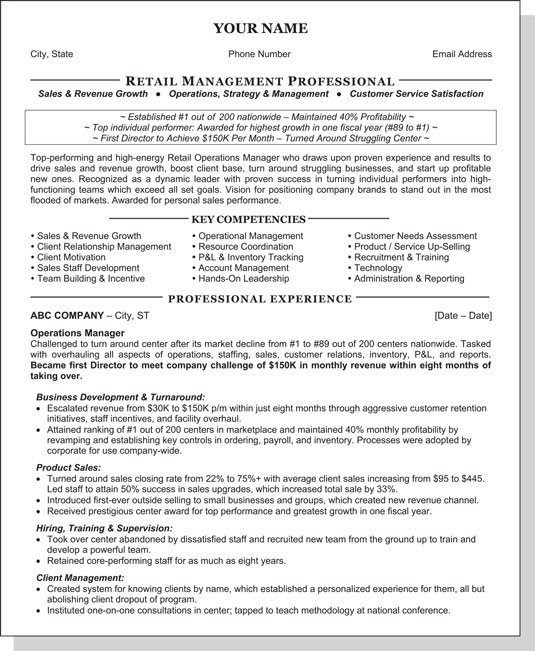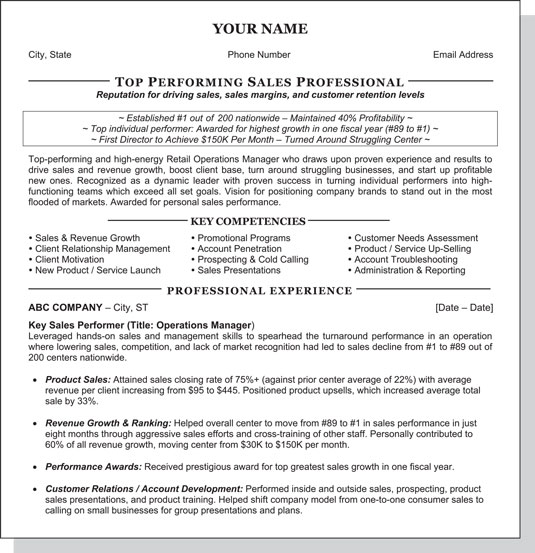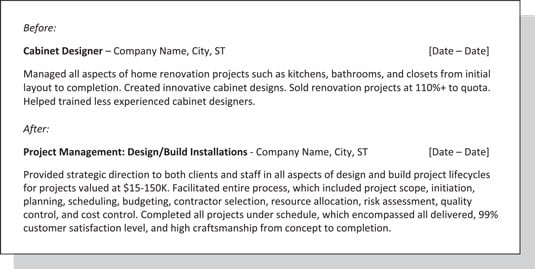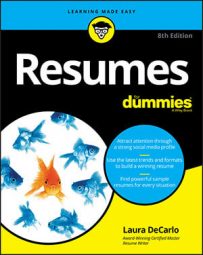Even though the computer age is upon us, fully customizing a resume remains a time-suck in busy lives — like preparing a five-course meal from scratch. That’s why you want to check out the OnTarget approach to customization described here.
Here’s how you can get started transforming your one-size-fits-all resume into a targeted resume:
- Read the job description to determine exactly what the employer needs. Mirror back what you find in each section of the OnTarget resume. Specifically, tweak your objective header statement and the contents of your summary, keywords, and employment history sections.
- Cut out irrelevant content from each section of your Core resume. Keeping this content won’t make you look better; instead it makes you look like you’re overqualified and not likely to stay — or uncommitted and likely to leave.
- Tweak wording to speak directly to the targeted position. This step may require crossover language if you are going from working with physicians and surgeons as your clients in the healthcare industry to executives in the IT industry. Look at the language used in the job description and use it in your OnTarget resume.
Staying OnTarget with your resume is a very simple process as long as you aren’t making a major life change such as returning to work after a gap or entering the workplace for the first time as a new graduate.
Draw words from job descriptions for your targeted resume
In order to spoon-feed a prospective employer directly what he is seeking in a position, take a look at the job description. If you find the description to be vague, perform an Internet search for that job title and look at other descriptions to get a deeper sense of what is desired.For example, if you have a background in retail sales, retail management, and customer service, the Core one-size-fits-all resume you have developed positions you to use all these skills. But now you are targeting a job in outside sales. When you review the job description, you’ll see no emphasis on retail or on management. From the description you can typically surmise:
- The objective header statement you need to use to show you are applying for this position.
- What the employer values in a candidate, which you can play up in your summary section and in your results-focused job descriptions.
- The key skills that you need to list and emphasize in your keyword section and then later connect with responsibilities and CAR stories in your professional experience section (job descriptions).
- The wording you need to adopt to make your experience feel as relevant as possible. This is crossover language where you speak in the new profession’s language and not in your old profession’s language.
 This Core one-size-fits-all resume for a job seeker who last held a position in retail operations management makes her overqualified for targeting a sales position.
This Core one-size-fits-all resume for a job seeker who last held a position in retail operations management makes her overqualified for targeting a sales position.In the following figure, the same job seeker appears perfectly qualified for this job.
 This OnTarget resume is for the same job seeker, but the focus of the content has been changed based on the target job description to complement an opportunity in sales.
This OnTarget resume is for the same job seeker, but the focus of the content has been changed based on the target job description to complement an opportunity in sales.Use crossover language to be OnTarget
Imagine you need to cross a bridge to reach your prospective employer, have him open the door, and welcome you in. When you reach that door and he speaks the language of healthcare and you speak that of engineering, your interaction will be as if you are from two different countries. He’ll close the door, unsure of why you came knocking, and you will go away feeling frustrated.But it never has to be that way if you discover how to use crossover language when writing your OnTarget resume.
Luckily, crossover language is easy to apply when you have looked at the job description for your target position. Does the employer refer to clients as “patients”? Are their customers called “members” or “key decision-makers”? Do they “sell” or “consult”? Are their products “cardiothoracic medical devices” or “high-tech equipment”?
After you have a feel for this language, you can begin changing the wording in your Core resume to reflect the target for your new OnTarget resume.
When choosing crossover language for your OnTarget resume, don’t use words that you don’t have the knowledge to support in an interview. You must truly understand the language you’re using in your resume. Be sure to dig deep, do your homework, and be able to talk in the language of your target industry. Otherwise, you may find yourself embarrassed in an interview.
The following figure shows a great example of using crossover language to target a new type of position. The job seeker’s before language pigeonholed him to home cabinet projects; after he targeted his resume, the specific crossover language demonstrated his match for project management. An example of revising a job summary using crossover language.
An example of revising a job summary using crossover language.Job descriptions aren’t the only place you can learn about language when targeting a position that may represent a change in industry or responsibility. Look at the Occupational Outlook Handbook, perform general searches by job title, and visit the professional association for that industry. You can uncover a lot of key language, core responsibilities, and strengths a particular type of position and industry require to help you make your resume a strong OnTarget match.
Going OnTarget with your resume can seem time-consuming. However, you will rapidly find that if you are targeting the same type of position over and over again, you only have to change a few words after the first customization. So be sure to save a copy of each new target you create. That way, when the next sales position or operations manager position comes along that you want to target, you can open that file, perform any needed customization, and be ready to go in a matter of moments.

